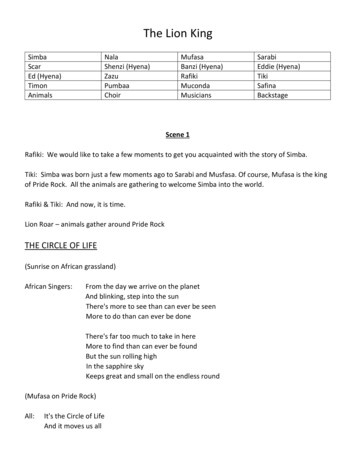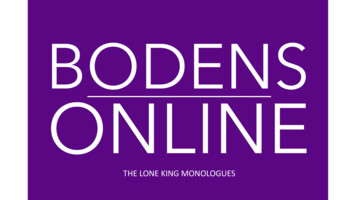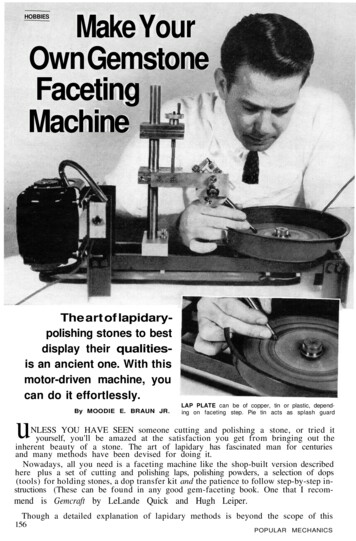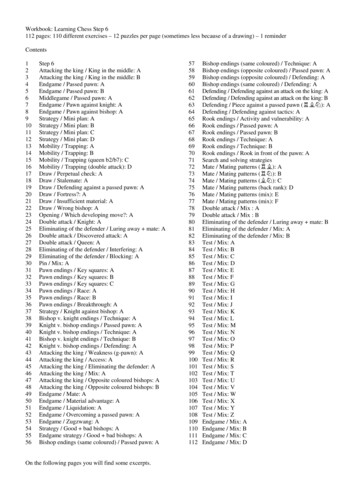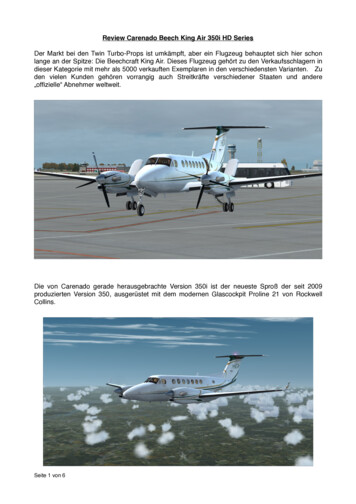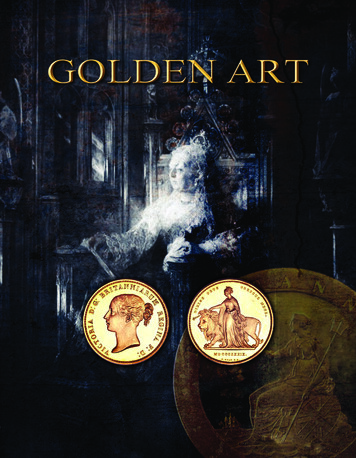
Transcription
King of Hobbies, Hobby of KingsImageThis title has been used to describe rare coincollecting (numismatics) for decades. To understand this regal title, we must contemplate theorigin of numismatics. While there are millions ofcoin collectors in the United States, numismaticsdid not begin there. Long before the United Stateswas ever conceived of, coin collectors sought outthe finest rarities for their collections.The rule of the Sovereigns ofthe British Empire was quitedifferent from the democraticgovernments of today. Everything was aboutthe will, desire, and personal tastes of the Kingor Queen. These Sovereigns considered theportrayals of their personal likenesses to bethe epitome of power, prestige and honor. Toplace any other object of art on an equal planewould have been tantamount to heresy to theserulers. Therefore, the ultimate object would notbe merely a painting of the Sovereign, but asculpture of the Sovereign’simage engraved on the mostprecious metal known, gold.Such great importance wasgiven to the careful sculptingof the King’s image that anunsatisfactory portrayal couldlead to the engraver’s death!The minting of a gold coin bearing the imageof a recently crowned King or Queen was notmerely coinage for the masses. It was also anexpression of reverence for the new Monarch;an honor of the highest order for the artist;and the creation of the newest masterpiece ofGolden Art.These early numismatists were in fact nobles andthe most elite among them were Kings. While itis possible to trace numismatics back in time toancient Rome, numismatics truly began in theworld’s greatest empire, Great Britain. At a timewhen a single large gold coin would be equivalentto a man’s wages for a year, wealthy noblespursued their passion for collecting by assemblingsets of the finest gold coins. Great art was born inthe Renaissance, yet much of it deteriorated withtime because it was created with paint and canvas.At the same time, great art was also being handcrafted into precious gold that would last forever.International PoliticsThe magnificent art works created on canvas werein some ways inferior to art engraved in preciousmetals, for the political importance of coins wasgreater than any other work of art. The Kings andQueens who ruled Great Britain and controlledits coinage created a rich artistic and historicalheritage through great gold coins. These rulershad several objectives with the creation of goldcoinage beyond the mere functional job offacilitating commerce. These included Image;International Politics; Religion; and Legacy.Long before the invention of media, newspapersor even the printing press, coins became thevery first advertising medium. England usedpolitical messages and images on its goldcoinage to pursue its grand world-conqueringagenda. Important victories in battle werecommemorated by incorporating variousimages or words associated with the battlein the design of a coin. For instance, historyattributes the great importance of London asthe world’s economic center in the 17th centuryto Great Britain’s domination and conquest ofAfrica, and to the gold taken from there. KingCharles II established formal control over largeparts of Africa with the formation of the RoyalAfrican Company. Gold mined in Africa wasbrought to Great Britain and made into coins
bearing the Company’s logo - anelephant with a British crownsitting upon it. This logowas placed beneath thehuge bust of King CharlesII to signal to the world thatGreat Britain was the world’sgreatest power.ReligionStarting in the early 1300’s King Edward IIIcreated the world’s first gold coins with Bibleverses incorporated into the design. The desireto spread the Christian religion was one of GreatBritain’s major goals. This practice continuedfor many centuries. In fact, 794 different typesof British coins bear Bible verses or fragmentsof verses. Other nations used the Bible on theircoins, but none so extensively as Great Britain.Legacy and ValueToday with major works of art regularly bringing 100 million to 250 million and some UnitedStates rare coins valued at up to 20 millioneach, it is time to reflect upon the trulyremarkable works of art which knowledgeablenumismatists have appreciated for centuries.Rare gold coins of the British Empire providethe ultimate collecting and investingexperience. The coinage of the British Empireportrays the history of the rise and breakup ofthe world’s greatest empire. These coins aremagnificent in their art, style, range of sizes,and historical account.Great Britain holds first place as the world’slongest series of coins. Coins have been mintedon its soil for 2,150 years - nearly 10 times thelength of time the US has produced coins. Asa result of this, Great Britain’s coins have alsoheld first place as the world’s most valuablethroughout all of numismatic history, untilrecent times. Sophisticated marketing in theUS has changed the marketplace, but it hasalso created a spectacular opportunity to buyEuropean coins at bargain prices.A magnificent handmade coin portrayingthe image of Henry VIII seated on his thronecompares favorably to other great works of artfrom that period, but at a fraction of the cost(even though only ten or twenty of these maystill exist). When United States numismatistscompare rare coins to great paintings, they oftenpoint to the great disparity in value between themediums as a reason to consider purchasingrare coins. As valid as this comparison is, an evengreater gap exists between Great Britain rarecoins and paintings.The huge disparity in value between Great Britainrare coins and United States rare coins exists as aresult of the differing rates of modernization andsophistication of the numismatic markets of thetwo continents. We will delve deeper into directcomparisons later, but consider this now: A 1999United States copper penny, a coinso common and worthless thatmost of us would not bother topick it up off the street, soldfor 138,000 at auction. Thisis despite the fact that over5 billion of them were minted.This particular penny is a rareerror, but nevertheless it is only a penny. For amuch smaller amount one could own a 500 yearold, very rare Henry VIII gold coin in high gradecondition.The history of this great gap in pricing isalmost as interesting as the history of the coinsthemselves. Great Britain’s rare coins were themost valuable in the world throughout historyuntil the early 1960’s. This was when a majormodernization of the United States rare coinmarket began. Now fifty years later the Europeanrare coin market is just beginning this dramaticprocess. The modernization of the US rare coinmarket created a massive bull market, the likesof which are unparalleled in the financial world.Europe is next.
Great Britain / United States ComparisonsOn these two pages are a few examples of the huge disparity in value between British and USrare coins. The coins selected are of the same size, metal, and importance. In all cases the Britishcoins are rarer than the United States coins, yet their current prices are dramatically lower; 90%lower on average.(Source: PCGS Price Guide.)1844 English SovereignGrade: MS-66Rarity: 20 knownCost: 9,8001844 US Liberty 5Grade: MS-66Rarity: 25 knownCost: 100,0001828 English SovereignGrade: MS-63Rarity: 7 knownCost: 75,0001829 US Capped Bust 5Grade: MS-63Rarity: 9 knownCost: 675,0001726 English 2 GuineasGrade: MS-64Rarity: 75 knownCost: 55,0001795 US Bust 10Grade: MS-64Rarity: 100 knownCost: 600,000
Great Britain / United States Comparisons1837 English Gold CrownGrade: MS-66Rarity: 4 knownCost: 220,0001927-D US St. Gaudens 20Grade: MS-66Rarity: 17 knownCost: 2,200,0001663 English Simon Petition CrownGrade: MS-63Rarity: 13 knownCost: 660,0001804 US Silver DollarGrade: Proof-63Rarity: 15 knownCost: 4,500,0001656 English 50 ShillingGrade: Proof-64Rarity: 4 knownCost: 475,0001804 US Draped Bust 10Grade: Proof-64Rarity: 4 knownCost: 4,750,000
The History of the Modernization of the Rare Coin MarketPrior to 1962, all coin markets in the world used asimple four point grading system and an annualprice catalogue to determine value. The US beganmodernizing its market in 1962 in a dramaticseries of steps that the rest of the world has yet tofollow. This history of the modernization of the UScoin market is outlined below.1962 - TeletypeThe teletype machine linked rare coin dealersaround the United States with the very first realtime, nationwide pricing and communicationsystem. Dealers were able to type out messagesoffering to buy or sell specific coins and havethem instantly seen by other dealers across theUnited States.1963 - Coin Dealer NewsletterSome method of analyzing the thousands ofteletype messages was needed to bring orderto the market. This began with the weeklypublication of the Coin Dealer Newsletter (CDN)in 1963. Published every week since that date,the CDN compiles and lists the current Bid andAsk prices at which dealers are willing to buyand sell for all US rare coins. The CDN is usedby everyone in the business, including dealers,collectors and investors.The importance of the CDN to the modernizationof the United States coin market cannot beoverstated. Without meaningful, readily available,and continually updated pricing data, theimmense bull market in US rare coins would neverhave occurred.1980’s - Rare Coin Mega ShowsIn the 1980’s US rare coin shows started growing tomega proportions with up to 1,000 dealer tablesand 20,000 attendees. The unique nature, sizeand short duration of these coin shows meantthat tremendous levels of business were nowpossible face to face. Today as many as ten ofthese mega shows are held each year in the US inaddition to innumerable smaller shows.1986 - Professional Coin GradingDespite the revolution in rapidly updated pricinginformation, more technological advanceswere still needed to bring true financialacceptance of rare coins into the mainstreamfinancial world. Prior to 1986, all rare coinsminted from all countries were bought andsold in person, because the buyers and sellershad to agree that the coins were genuine. Theythen had to agree on the grade of the coin inorder to determine its value. Since counterfeitsare a problem with all antiquities, andgrading requires considerable knowledge,the buying and selling of rare coins waslimited by necessity to the most experiencednumismatists. An independent third party thatcould guarantee authenticity and grade wasan absolute necessity if the US rare coin marketwas going to attract serious levels of investmentfrom investors.To solve this problem thirty-three of the world’sforemost rare coin dealer-graders (one of whomis now Golden Art LLC’s Chief Numismatist) metover a period of many months in 1986 to forma dealer network and create modern gradingstandards for all US rare coins. This majorhistorical event allowed for the creation of theProfessional Coin grading Service (PCGS), thefirst independent third party certification service.Today, PCGS is a publicly traded company thathas certified more than 26 Billion worth of rarecoins, ushering in the greatest bull market in anyfield of antiquities the world has ever witnessed.
70 Point GradingPCGS employs teams of three graders whoindividually blind grade each coin, without theothers knowing their grade. Afterwards a finalizerreviews the grades and certifies each coin. Thegenuine coins are then sealed in a tamper proofholder. The holder contains all of the informationneeded to attribute and price the coin. PCGSgrades coins on a point system of 1 to 70. Oneis the lowest grade. A grade of 70 is perfect,certifying that the coin left the mint with nodefects of any kind.The dual innovations ofthird party certificationand grading, and theelectronic tradingof rare coins, haverevolutionized thefield of rare coins. Ithas been transformedfrom a sleepy hobbywith a few thousandenthusiasts into a hugeinternational business wherebillions of dollars change hands each year.1987 - Numismatic Guaranty Corp1988 - Population ReportFollowing in the footstepsof PCGS, the NumismaticGuaranty Corporation(NGC) was created by sixexperts, one of whom isnow Golden Art’s ChiefNumismatist. While othergrading companies exist,today PCGS and NGCdominate the business ofgrading coins. NGC hasgrown to become theWorld’s largest third partycertification service. Like PCGS, NGC guaranteesboth the authenticity and the grade of the coinsthey certify.Among all fields of antiquities, only rare coinshave meaningful data available regardingrarity. Prior to the creation of PCGS and NGC,only experienced numismatists truly understoodwhich coins were rare and which were not. Thisexclusive knowledge could not be appreciatedby the broader marketplace until moderntechnology allowed the creation of thePopulation Report. The Population Report(sometimes referred to as the Census Report)listed data on every certified coin in every grade,quantifying rarity for all to see. This sudden surgein information allowed the mainstream financialworld to truly understand rarity. As a result, themarketplace could now properly value rarity.This series of ground-breaking innovationscreated a huge bull market for rare coins thatremains unparalleled in the world of antiquities.1987 - Electronic TradingThe next phase of the modernization of themarket was the creation of the first electronictrading system for certified coins, the AmericanNumismatic Exchange (ANE). For the first timeit was possible to buy and sell United Statesrare coins sight-unseen, electronically, in a livereal-time marketplace. This major advance intechnology made United States rare coins thefirst, and still to this day, the only antiquity thatis also a commodity. Today millions of dollarsof rare coins are bought and sold daily on theelectronic trading system, similar to the NASDAQ.Golden Art LLC’s Chief Numismatist was one ofthe founders of the ANE.
The “Best of the Best”The modernization of the US coin market ledto spectacular across-the-board increasesin value for all rare coins in the hundreds ofpercent. However, a certain class of rare coinsoutperformed even this amazing performance,rising more than 10,000% in value. The reasonthis class of rare coins is so desirable andvaluable is that they are the “Best of the Best.”These are coins that are both extremely rare andin exceptional condition.In the pre-modernized US rare coin market,exceptional or “gem quality” uncirculatedcondition (Mint State/MS-64 and higher) rare coinswere worth only a modest amount more thanthe same type of rare coins in the lowest gradeof uncirculated condition (MS-60). For instance,any common year 5 Indian head gold piece in1970 was worth 40 in MS-60 condition and 50in MS-65 condition. Today the MS-60 coin hasappreciated in value to 565. However, the extra 10 you spent for the higher grade MS-65 coin in1970 was well worth the expense, since it is worth 20,000 today!Condition RarityWhat happened to cause this huge pricedisparity? Both coins are in brand new,uncirculated condition. The difference is thatlarge numbers of coins are known to exist inthe lowest grade of uncirculated (MS-60) andvery, very few are known to exist in gem qualityuncirculated (MS-65) condition. In 1970, fewcollectors and dealers realized how rare this coinwas in MS-65 condition. The Population Reportrevealed just how rare the 5 Indian gold coinwas in exceptional condition. This coin is knownas a “Condition Rarity.” In other words, it is a cointhat is rare due to its gem condition.The phenomenon of Condition Rarity coins thatare worth enormous premiums above averagequality only occurs in the North Americanmarkets. In the rest of the world the markets arejust starting to mature, and Condition Rarity coinscan still be purchased at bargain prices. Thebest investment opportunities in the world arethe Empire Nations of Great Britain, France andSpain. There are huge numbers of collectorsfor these coins, because they were minted andcollected all over the world. These countries arejust starting to see their markets modernized.As a result they will see their “Best of the Best”rise in value tremendous amounts just as theUS already has. A secure floor in value existsbecause these markets have not yet greatlyaccelerated in price, therefore allowing for littleor no downside risk. 1 million invested in US Condition Rarity coins in1970 would be worth 1 billion today. Our planis to purchase at least 50 million in ConditionRarity Empire Nation coins. Our goal is to helpbuild and modernize the coin systems in Europeand grow this collection to 1 billion or more.The demand for rare coins is extremely intensein Europe. European rare coin values have beenrising steadily for decades, although at a slowerrate than US rare coins.Europeans have a much greater appreciationfor gold than anyone else in the world becausetheir currencies have been debased so manytimes in the past. The German and French HyperInflations are good examples of why Europeansdon’t trust paper money. This opportunity is timesensitive as PCGS and NGC are now buildinga presence in Europe with the goal of fullmodernization of these markets.
What Makes a Rare Coin Valuable?Four criteria determine the value of a rare coinregardless of the country that minted it. TheGolden Art strategy is to buy rare coins that arethe best in all four categories:1. Rarity2. Familiarity or popularity3. Metallic content4. Physical condition (grade)1. RarityA. Date RarityCoins are consideredrare for one of tworeasons: date rarity andcondition rarity. The mostvaluable rare coins in theworld are those where fewexamples are known to exist of that particular typeand date. For instance, only five US 1913 Libertyhead nickels are known to exist. This coin has soldfor more than 5 million.B. Condition RarityAs mentioned earlier, coins are also consideredrare if they are in exceptional condition. This istrue only if very few exist in gem condition - eventhough there may be many examples known toexist in low grade. A good example is the 1884-SSilver Dollar. It is worth 65 in a grade of EF-40,which is a circulated coin with some wear.(EF means Extremely Fine.) However, the samecoin in MS-67 Uncirculated condition is worth anastounding 500,000. This enormous differencein value for the exact same coin is a result of thefact that thousands of average quality (EF-40)1884-S Silver Dollars are known to exist, versusjust one that is known to exist in near perfect(MS-67) condition.2. Familiarity / PopularityThe Mona Lisa is probably the most valuablepainting in the world, mainly because nearlyeveryone has heard of it. The painting is bothfamous and popular. The same can be said ofvaluable rare coins. Yet a rare coin from a thirdworld nation that few care about is of little value.Even with the coins of important countries,popularity is still vital. For instance, the US 1873three cent piece made in silver is a rare coin ofwhich only 600 pieces were made. Yet it is worthonly 4,250 in gem quality MS-66 condition.By contrast, 1.2 million US 1914-D Lincoln centswere made. But a gem quality MS-66 exampleis worth 125,000. Why is there such a majordifference in value between these two coins?Quite simply, Lincoln cents are extremelypopular amongst collectors. By contrast veryfew people collect 3 cent silver pieces, andmany don’t even know such coins exist.3. Metallic ContentThe most desirablemetal in which coinshave been mintedis gold. It shouldtherefore comeas no surprisethat the mostvaluable rarecoin in the worldis made of gold.While copper, nickel,and silver coins can beworth more than 1 millioneach, the best candidates for great priceappreciation are usually gold coins.4. ConditionCoins are graded on a 70 point scale, with 70being the best. Very small differences in gradecan make a huge difference in the value of acoin. For instance, there are many rare coinsworth over 100,000 in superb condition, yetthey are worth very little in poor condit
the finest rarities for their collections. . verses incorporated into the design. The desire to spread the Christian religion was one of Great . was going to attract serious levels of investment from inv
